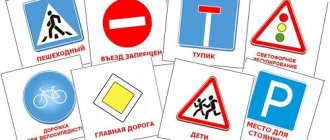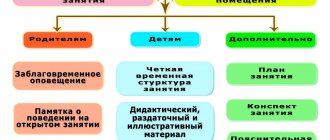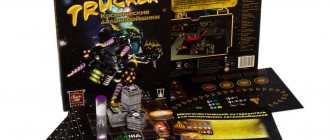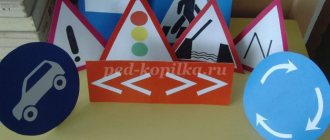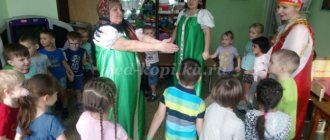Summary of a lesson on traffic rules in kindergarten in the senior group “Journey to the land of road signs”
Summary of an open lesson on traffic rules “Travel to the land of road signs.”
Senior group Educational area: “Social and communicative development” Integration of educational areas: “Cognitive development”, “Speech development”, “Artistic and aesthetic development”, “Physical development”. Types of children's activities: play, communication, cognitive, speech, productive. Form of implementation: subgroup. Program content: 1. Introduce children to the address of the kindergarten; identify the level of knowledge of children on traffic rules; 2. consolidate children’s knowledge of traffic rules, road signs and traffic lights; to develop in older children knowledge about the culture of behavior on the road and in transport; 3. consolidate children’s ability to correctly construct and use complex sentences in speech; 4. continue to develop teamwork skills, the ability to solve assigned tasks and work in a team, coordinate their actions; 5. cultivate feelings of mutual assistance and support. Preliminary work: Conversations on traffic rules, examination of illustrations and information posters on traffic rules.
Reading works: G. Georgieva “Traffic Light”, S. Mikhalkov “Uncle Styopa - Policeman” Materials and equipment: pictures of traffic lights, cards with road signs, information posters on traffic rules, envelopes with letters, ball, easels, material for group work on creating a collage. The group room is designed for a trip to the land of “Road Signs”. Progress of the lesson
Children enter the group. Educator: Look how many guests we have today. Let's say hello to them. Children: Hello! Educator: Guys, on the way to kindergarten I met the postman, and he gave me a letter. From whom we now find out. (Reading the letter) “Dear guys, gr. "No. 3", help us! We, residents of the land of Road Signs, are in trouble. We were captured by Baba Yaga. She bewitched all the road signs, mixed up all the traffic rules, and broke the traffic light. And now we have constant accidents in our country. Help us!" Educator: Here someone will correctly say: What kind of witchcraft is this? What kind of magic is this? Nothing happened. Well, the crossings have disappeared - Pedestrians will not cry, They will choose the paths themselves, Where to cross the road. Is the traffic light not working? Well, what grief is there in this: Red light, green light - Maybe there’s no point in it! Guys, what do you think, are traffic rules, traffic lights, and road signs necessary? Children: Yes, we need it! Educator: Then do you agree to help the residents of the country of “Road Signs” cope with trouble and Baba Yaga? Children: Yes, yes we agree! Children sit on chairs standing in two rows. Children are divided into two teams and collect “Road Signs” puzzles. Educator: Well, then let’s not waste time and hit the road. But first, let's hold hands and give each other smiles and good mood. After all, only together and in a good mood can we defeat Baba Yaga! Educator: And now you must guess the riddle; by guessing it, you will find out what kind of transport we will use on our trip. What a miracle - a long house! There are a lot of passengers in it. Wears shoes made of rubber and eats gasoline... (Bus) Educator: Correct! Now take your seats on the bus, and while we are driving and so that we don’t get bored, we will remember the rules of behavior in public transport. Rules of conduct for passengers in public transport: 1. Give way to someone who has difficulty standing (elderly people, a person who “feels unwell”, saying “please sit down.” 2. While the vehicle is moving, hold on to the handrails. Stand in such a way that do not interfere with the movement of passengers through the cabin. 3. In transport, it is indecent to laugh and talk loudly, discuss your problems on the phone and argue loudly with friends. If a person makes a comment to you, don’t be rude, take note of this! 4. You cannot litter in transport . It is forbidden to paint the seats, climb on them with your feet. 5. You cannot distract the driver of the vehicle from the trip, talk to him, or climb into his cabin. 6. In the vehicle interior, they do not comb their hair, do not clean their nails, do not pick their nose, teeth, ears 7. You need to prepare for the exit in advance (especially if there are a lot of passengers). Ask those in front: “Are you getting off at the next stop?” Apologizing, ask permission for you to pass, but under no circumstances push aside, making way for yourself. Educator: Well done guys, you turned out to be cultural passengers. Since our road is long and I want to see if you can solve the riddles ? She doesn’t know where she’s running. In the steppe it is level, in the forest it wanders, it stumbles at the threshold. What is this? ... (Road) This horse doesn’t eat oats. Instead of legs there are two wheels. Sit on horseback and race on it, but it’s better to steer. (Bicycle) It will oblige us to ride quietly, A close turn will show And remind you of what and how you are on the road... (road sign) I drink gasoline and eat oil. At least I'm not hungry at all. And without them I get so sick. That I won’t be able to go! (Car) I blink my eyes. Relentlessly day and night. I also help cars. And I want to help you... (Traffic light) Educator: Well done children! The riddles have been solved, and here is our stop! Oh, guys, what is this in the clearing, these are probably the tricks of Baba Yaga! She did something. Let's try to eliminate this obstacle and thereby help the residents of the country of “Road Signs”. Children stand on the carpet in the center of the group. When the signal is red, children sit down, when it is green, they walk, and when it is yellow, they stand) Educator: Everyone can see me at once. I'm hanging between two supports. My three eyes are burning. And my name is... (Traffic light) - Yes, guys, we fixed the traffic light. What is a traffic light for? Children: A traffic light is needed to regulate the movement of pedestrians and vehicles. Educator: Correct! Listen to the poem about what each traffic light sign means. At any intersection we are greeted by a traffic light and start a very simple conversation with a pedestrian: The light is green - go ahead! Yellow - better wait! If the light turns red, it means it’s dangerous to move! Stop! Let the tram pass. Be patient, learn and respect the traffic rules! (Ya. Pishumov) Children take seats on the “Bus.” Educator: Well, that’s good, our traffic light is working. And we move on to correct the tricks of Baba Yaga. - We continue our journey, but what’s ahead at the stop in the magical land? Guys, Baba Yaga worked here too, she bewitched all the road signs, and they forgot what they mean and what they are needed for. Guys, let's help them. Poems about road signs: Educator: The road signs are all very good. Both adults and children should respect them. Everyone knows that you can't live without rules. You can't live without road rules. We must all be careful on the road. 1. Sign “No Entry” (read by a child) The sign frightens drivers, prohibiting cars from entering! Don't try to rush past the brick! 2. Sign “Pedestrian traffic is prohibited” (read by a child) Pedestrians do not walk here in rain or shine. The sign tells them one thing: “You are prohibited from walking!” 3. Sign “No Bicycles” Remember the sign, friends, both parents and children: Where it hangs, you cannot ride a bicycle! 4. Sign “Pedestrian crossing” There is a pedestrian crossing at every intersection. It’s easy to cross the road here without any risk or hassle! 5. Sign “Beware of children” A boy and a girl were walking. All the drivers in the world ran into a triangle. They understand - these are children! 6. Sign “Underpass” There is a sign on the roadway. A special passage Everyone calls it an underground passage! 7. Sign “First aid station” My cat got sick on the road, I need a doctor to help. Don't worry my pussy, look. Medical help is coming! 8. Sign “Drinking water” There is a tap with water on the sign, And it’s hot outside. Don't be sad, passengers, you'll have water soon! Children use an information poster to tell them the rules of the road. Educator: Well done, guys! Helped road signs remember what they mean. - Well, we continue on our way. Guys, look at another stop, but what happens at it? Can I hear the people of the land of road signs crying? So it’s Baba Yaga again, she bewitched the residents and they forgot all the traffic rules. Let's help them remember the traffic rules. Children stand in a circle, the teacher throws the ball to the child and asks a question, the child answers the question and throws the ball back. All children in chorus: If you know the rules and always follow them, go ahead! Go ahead, lead your friends with you! Educator: Guys, here is the last stop. Look, some kind of envelope, let's see what's in it! So this is the game Catch the Ball” from the traffic light inspector. The game is not easy, you need to answer all his questions correctly, and thereby help the residents of the country of “Road Signs” remember them. Children sit on chairs. I will throw the ball to you and ask you questions, and you answer by returning the ball to me. 1. Who are “pedestrians”? 2. Who are the “drivers”? 3. What is a “sidewalk”? 4. What is a “roadway”? 5. Which side should you walk on the sidewalk? Why? 6. What is a “pedestrian crossing”? 7. What pedestrian crossings do you know? 8. What is a traffic light for? 9. Who are the passengers? 10. Is it possible to cross the road in front of approaching traffic? Why? 11. How to cross the street correctly? Children come to the table and paste cut out houses, cars, road signs, etc. onto a large sheet of paper. The teacher shows the resulting picture. Teacher: Well done guys! With our knowledge we defeated the witchcraft of Baba Yaga, her spell dissipated. And as a farewell, let’s give the residents of the country of “Road Signs” a painting that we will make ourselves. Educator: They don’t just walk along the street, around the city, When you don’t know the rules, It’s easy to get into trouble Be careful all the time And remember in front The driver and the pedestrian have their own rules! Guys, our journey has come to an end, we helped the inhabitants of the magical land of “Road Signs”, and we ourselves remembered the rules of the road. And inspector Svetofor - Svetoforich sent a parcel for our knowledge and gives you the “Honorary Pedestrian” certificate.
We recommend watching:
Summary of a lesson in kindergarten in the senior group on traffic rules. Notes of a lesson on traffic rules in the senior group. Reflective elements Summary of a game lesson on traffic rules in kindergarten. Senior group Summary of a lesson in kindergarten on traffic rules with design elements. Senior group
Similar articles:
Summary of a lesson on traffic rules in the senior group on the topic “Transport World”
Summary of a lesson on traffic rules in the senior group on the topic “Road signs”
Traffic rules lesson. Road signs. Senior group
Topic 3. Road signs.
All signs are divided into eight groups according to their purpose. All groups have “telling” names. Warning signs - warn, prohibitory - prohibit, informational - inform, etc. The first thing you must learn is to understand which group the sign installed on the road belongs to. And the authors of the Rules took care of this, simplifying the recognition process as much as possible.
A person associates attention with a triangle, and it is no coincidence that almost all warning signs are triangular in shape. These signs seem to shout to us: “There is danger ahead! Be careful!" You will also easily learn to distinguish traffic priority signs from all others. Firstly, there are few of them, and all of them (with the exception of two) are installed only before intersections. Secondly, they are unmistakably identified either by their symbols or are distinguished by the uniqueness of their form.
For example, sign 2.5 “Moving without stopping is prohibited” is the only octahedron in the entire family of symbols. Yes, and sign 2.4 “Give way” is also an original - it is the only triangle placed “upside down” (all other triangular-shaped signs stand as expected - on their base).
A person associates a ban, and indeed any restriction, with a circle. That is why prohibition signs are round in shape. At the same time, the prohibition signs have a strict appearance - black symbols on a white background, and even a red “screaming” rim. Of course, they forbid it! And what they prohibit is depicted on the sign. Sign 3.19, for example, only prohibits turning around, and everything else is welcome. Mandatory signs are also round in shape and therefore also impose restrictions on your movement. For example, sign 4.1.1 instructs all drivers: “Move straight!” Moreover, only directly and nowhere else. Prescriptive signs depict not what is not allowed, but what is allowed. Therefore, unlike prohibitory signs, their symbols are white and the background is blue.
"Signs of special regulations"
and “Information signs” provide the driver with various important information. In the first case - more strict, in the second - less strict.
For example, sign 5.5
informs the driver that he is driving on a one-way road, and this imposes some restrictions on his behavior. A one-way road has its own (special!) traffic mode, and the sign reminds the driver of this.
Sign 6.4
it simply informs the driver that he can park in this place with impunity.
A person associates information with a piece of paper, with a poster, with a screen, finally. That is why all these signs are either square or rectangular in shape. The background color can be different: blue, white, green or yellow. And this matters, which we will talk about a little later.
As for the “Service Marks”, they are absolutely all rectangular in shape, with a blue background, and it is not difficult to understand what is depicted on them. Finally, "Tablets". Almost all plates, unlike signs, are not color, but black and white. Plates are not used separately from signs. They are always adjacent to some sign and complement or clarify its action. For example, sign 8.5.2 “Working days”, posted separately on the road, looks like a misunderstanding. However, if you hang the same sign, for example, under sign 3.19 “U-turn is prohibited,” then this combination takes on a very specific meaning – “U-turn is prohibited on weekdays.” On Saturday, Sunday and holidays this restriction does not apply, you can turn around.
In addition, the driver (if he wants to understand the text of the Rules) needs to know that the sign can be:
– main,
– preliminary,
- repeated,
– duplicating.
These terms are not defined in the Rules themselves, but what is stopping us from reading the current GOST R 52289 - 2004 “Technical means of organizing road traffic. RULES FOR THE APPLICATION OF ROAD SIGNS, MARKINGS, TRAFFIC LIGHTS, ROAD FENCES AND GUIDING DEVICES.”
GOST R 52289 – 2004. Section 3 “Terms and definitions”.
Clause 3.3. Primary sign – a sign the need for installation of which is determined by road conditions in accordance with the requirements of this standard.
Before the intersection there is a sign 2.4 “Give way”. Traffic organizers considered that the installation of such a sign here is “ determined by road conditions in accordance with the requirements of this standard”
and, therefore, according to GOST, this is the most
basic sign.
But this is
a preliminary sign!
Now drivers are informed that after 300 meters the main sign 2.4 “Give way” will be installed.
GOST gives the following definition:
Advance sign
– a sign installed before the main sign and warning drivers about an upcoming change in traffic mode or object, information about which is contained on the main sign
.
But it may be so - the main sign
(the need for installation of which is determined by road conditions in accordance with the requirements of this standard), followed by
a repeat sign
(and even with a sign clarifying the effect of the main sign).
GOST gives the following definition:
A repeated sign
is a sign installed behind the main sign and confirming its information.
Finally, what is
a duplicate sign?
Duplicate sign
installed on the same cross-section of the road as the main sign. A duplicate sign can be installed above the road, or placed on the dividing strip, or even on the left side of the road (if there are no more than two lanes in the oncoming direction).
GOST gives the following definition:
A duplicate sign
is a sign installed in the same cross-section of the road as the main sign, which serves to increase the reliability of information perception by traffic participants.
